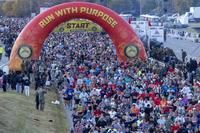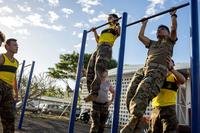As a military recruit preparing for the challenging demands of future basic training and perhaps more advanced special operations selection, you understand the importance of getting good at multiple forms of cardio conditioning. This type of training means putting in the time for running, rucking and maybe even swimming with fins, depending on the training you wish to attend.
These three modes of travel can make you a "cardio machine," but they will place significant demands on your body. Your feet, shins, knees, hips and lower back can feel the strain, but you may soon learn about iliotibial band (ITB) syndrome. Unfortunately, pushing yourself to new limits often brings about conditions such as ITB syndrome, which can be frustrating and debilitating.
Progressively adding miles of running and rucking each week is tough, but the extra swimming with fins can push your ITB to inflame and nearly lock up the knee joint. However, with a strategic approach that includes physical therapy, stretching/massage techniques, and a smart reduction in time and distance for a few weeks, you can manage ITB syndrome effectively and continue your preparation without unnecessary delays.
Understanding Iliotibial Band Syndrome
The iliotibial band is a thick band of tissue that runs outside your thigh, from your hip to your knee. Its primary function is to stabilize and support the knee during running and other activities. When you increase your running mileage each week or add heavy rucking and swimming with fins to your regimen, your ITB can become irritated and inflamed, leading to ITB syndrome.
This is a common overuse injury, especially with people new to running, rucking and/or swimming with scuba fins. This condition results in pain on the outer part of the knee and typically not the upper leg and hip region. This pain can be felt when walking down steps and can become severe enough to hamper your running, rucking and swimming training.
Physical Therapy and Rest
One of the most effective ways to manage and heal ITB syndrome is through physical therapy, anti-inflammatory medication, foods and supplements combined with adequate rest, especially from rucking and swimming with fins. This approach allows your body to repair itself while you focus on reducing inflammation and pain. Consulting a physical therapist (PT) specializing in sports injuries is advisable. A PT can tailor a recovery program specific to your needs and goals.
Initially, your therapist may recommend significantly reducing your training intensity to alleviate acute symptoms. But often, many find other nonimpact cardio activities such as bike workouts and swimming without fins effective in helping to maintain and even improve cardio function when unable to run, ruck or swim with fins.
Stretching and Flexing for Relief
The ITB does not stretch well, but the surrounding leg muscles, hips and glutes do. Strengthening and stretching the hip flexors, glutes and leg muscles will help relieve pain and promote healing. Besides, high mileage in running, rucking, swimming and weak glute muscles are culprits to ITB syndrome.
Effective stretches and flexes can reduce tension in the ITB and the surrounding muscles. Incorporate the following 30-second stretches or holds 3-4 times into your daily routine:
- Donkey kicks: Work the glutes, hips and lower back by kicking one leg backward while in an all-fours position. Work to feel both glute and hip flexor stretches on the up/down portions of the kick.
- Dirty dogs: Work the glutes and hips with a leg lift to the side while in the all-fours position.
- Swimmers: Flex your glutes and lower back with little flutter kicks while lying on your stomach.
Massage Techniques
Besides physical therapy and stretching, various massage tools and techniques can expedite recovery. These methods can relieve muscle tightness and enhance blood flow, promoting healing. They include massage guns, vibrating tools and deep-tissue massage techniques with your hands, balls or foam rollers on the many pressure points of the hips, legs, and buttocks.
Limiting the chances of ITB syndrome from recurring requires a consistent and balanced approach to training and recovery. Gradually increasing your running miles (10%-15% per week), ensuring proper footwear and maintaining strong core and hip muscles can help mitigate the risk. Smart training plans that progressively add miles of running, rucking and swimming will help you not get this aggressive, overuse injury. Consistency with logical progressions, stretching, strengthening and massaging after long training days is the key. Don't skip mobility training.
You can manage ITB syndrome through patience, as it may take 6-8 weeks to fully heal with no pain when walking downstairs or at other training events. By adopting these practices, you can confidently progress toward your military and special ops goals, ensuring your hard work and dedication are not in vain. You should still train even with this ache, but resorting to more swimming without fins and biking may be helpful tools to stay in shape while you work through this pain.
Want to Learn More About Military Life?
Whether you're thinking of joining the military, looking for fitness and basic training tips, or keeping up with military life and benefits, Military.com has you covered. Subscribe to Military.com to have military news, updates and resources delivered directly to your inbox.


















